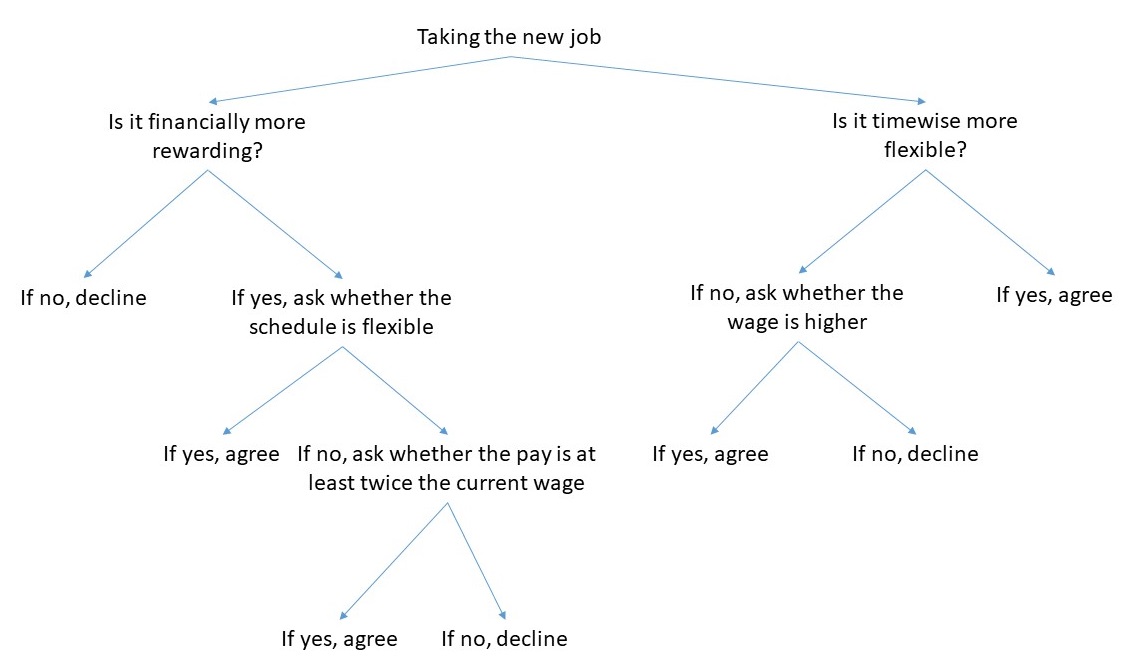The problem I face is the lack of stable and satisfying employment. The current job is emotionally taxing, since it does not allow me to spend quality time with my family and myself. It has become apparent that the solution lies in finding another job, which would increase my satisfaction. Understanding what factors influence employment satisfaction is essential in ascertaining what should be considered while making the decision.
In order to solve this issue, a non-programmed decision is necessary. The conditions surrounding this decision consist of both uncertainty and risk. This decision can only be made by one individual, since it is a personal problem. The crux of the problem is personal dissatisfaction with the current job. The first symptom is financial inadequacy, stemming from the disproportionate ratio of efforts and rewards. The second symptom is the lack of free time, which is consumed by the job’s requirements. The first cause is the low wage size, which does not allow accumulating money. The second cause is the necessity to work more hours in order to pay the bills. The subsequent resolution to the problem of employment dissatisfaction lies in acquiring a better-paying job with a flexible schedule, which can also be performed on a remote basis.
This decision will allow me to spend more time with my family, while accumulating savings. Therefore, any alternative should correspond to two essential standards, the first of which is wage size. It must be larger than the one I have currently in order for the job switch to be meaningful. The wage that I actually want should be at least twice the size of my current one. The second standard is that the employer must allow me to decide on my work schedule. Ideally, I want to be able to do the job from home as well.
There are two pieces of information that I require for choosing an alternative job. First, I have to know the exact income I will have after paying all taxes. Second, I need to know how schedule is planned – whether it is nine-to-five, flexible, or project-based. The technology that will help me find an alternative takes the form of online employment services, such as LinkedIn and Jooble (Iosif & Grigore, 2021). The possible alternatives include four job positions that differ from each other regarding wage and schedule. Figure 1 shows a decision tree, designed for ascertaining the proper course of action in case, a job opening does not correspond to one of the standards.

In order to compare the alternatives, a cost-benefit analysis will be utilized. The major benefit that I pursue is higher financial compensation for the job. If the pay is high enough, the lack of flexible schedule can be ignored. The second benefit is the option of planning a schedule on one’s own. If such an opportunity is accompanied by higher wage, then the benefits outweigh the costs. However, a job with flexible schedule without better compensation is not as preferable and should be declined.
The costs of the decision stem from the risk of choosing the job that does not bring sufficient satisfaction. First, the actual earnings may be lower than what the current job provides. Second, the amount of free time may remain the same or even decrease in a new position. Third, it is possible that the new job will have no remote option. Finally, leaving the current job may result in me losing the current income and not finding new sources.
The plan for implementing the decision consists of four steps. First, it is necessary to access online recruitment databases and start searching job openings corresponding to my qualifications. The second step is to contact employers that can provide me with the job that fits me and ask for details regarding the working conditions. Third, it will be necessary to wait for the invitation to the interview. The final step is to decide whether other alternatives offer better conditions.
The first indicator that will inform me of the correctness of the decision is the amount of earnings that I will retain after filing the tax declaration and paying the bills. The second one is the estimated number of hours that I will be able to dedicate to myself and my family without the fear of being interrupted by work issues. The subsequent controls that will highlight the appropriateness of decisions are the average amount of money that I can accumulate into savings and the average number of hours actually spent with the family. Commitment to a specific decision can be avoided by constantly checking the established indicators, since they rely on objective data.
If employment satisfaction does not increase after changing the job, it is important to reevaluate the standards. If the job pays sufficiently, but the amount of free time is still limited, it may be a sign that wage size is not that important. Similarly, if satisfaction increases in a low-paying job with a flexible schedule, it may be a sign that the wage is not that significant.
Overall, employment satisfaction is comprised of two factors – wage size and free time. These indicators will serve as vital criteria for evaluating the existing job openings. The inability to meet either of these criteria constitutes the major risks of changing jobs. This analysis has taught the importance of dissecting emotional satisfaction into physical influences. Armed with this knowledge, I will be able to manage my emotional state when making important decisions.
Reference
Iosif, L., & Grigore, T. (2021). Recruitment and selection of human resources within the Thecon Organization. Acta Universitatis Danubius. Communicatio, 15(1). 114-126.
